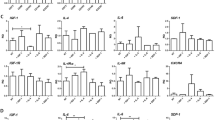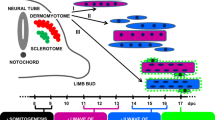Abstract
The Tat protein is able to translocate through the plasma membrane and when it is fused with other peptides may acts as a protein transduction system. This ability appears particularly interesting to induce tissue-specific differentiation when the Tat protein is associated to transcription factors. In the present work, the potential of the complex Tat-MyoD in inducing equine peripheral blood mesenchymal stem cells (PB-MSCs) towards the myogenic fate, was evaluated. Results showed that the internalization process of Tat-MyoD happens only in serum free conditions and that the nuclear localization of the fused complex is observed after 15 hours of incubation. However, the supplement of Tat-MyoD only was not sufficient to induce myogenesis and, therefore, in order to achieve the myogenic differentiation of PB-MSCs, conditioned medium from C2C12 cells was added without direct contact. Real Time PCR and immunofluorescence methods evaluated the establishment of a myogenic program. Our results suggest that TAT- transduction of Tat-MyoD, when supported by conditioned medium, represents a useful methodology to induce myogenic differentiation.





Similar content being viewed by others
References
Benkirane M, Chun RF, Xiao H, Ogryzko VV, Howard BH, Nakatani Y, Jeang K (1998) Activation of integrated provirus requires histone acetyltransferase. J Biol Chem 273:24898–24905
Bentzinger CF, Wang YX, Rudnicki MA (2012) Building muscle: molecular regulation of myogenesis. Cold Spring Harb Perspect Biol 4:a008342
Chamberlain G, Fox J, Ashton B, Middleton J (2007) Concise review: mesenchymal stem cells: their phenotype, differentiation capacity, immunological features, and potential for homing. Stem Cells 25:2739–2749
Chen JCJ, Goldhamer DJ (2003) Skeletal muscle stem cells. Reprod Biol Endocrinol 13, 1:101
Cheung TH, Rando TA (2013) Molecular regulation of stem cell quiescence. Nat Rev Mol Cell Biol 14:329–340
Col E, Caron C, Seigneurin-Berny D, Gracia J, Favier A, Khochbin S (2001) The histone acetyltransferase, hGCN5, interacts with and acetylates the HIV transactivator, tat. J Biol Chem 276:28179–28184
Dezawa M, Ishikawa H, Itokazu Y, Yoshihara T, Hoshino M, Takeda S, Chizuka I, Nabeshima Y (2005) Bone marrow stromal cells generate muscle cells and repair muscle degeneration. Science 309:314–317
Dietz GPH, Bähr M (2004) Delivery of bioactive molecules into the cell: the Trojan horse approach. Mol Cell Neurosci 27:85–131
Dugan JM, Cartmell SH, Gough JE (2014) Uniaxial cyclic strain of human adipose-derived mesenchymal stem cells and C2C12 myoblasts in coculture. J Tissue Eng 5:2041731414530138. doi:10.1177/2041731414530138
Eom YW, Lee JE, Yang MS, Jang IK, Kim HE, Lee DH, Kim YJ, Park WJ, Kong JH, Shim KY, Lee JI, Kim HS (2011) Effective myotube formation in human adipose tissue-derived stem cells expressing dystrophin and myosin heavy chain by cellular fusion with mouse C2C12 myoblasts. Biochem Biophys Res Commun 408:167–173
Fittipaldi A, Giacca M (2005) Transcellular protein transduction using the tat protein of HIV-1. Adv Drug Deliv Rev 57:597–608
Freestone JF, Carlson GR (1991) Muscle disorders in the horse: a retrospective study. Equine Vet J 23:86–90
Galli D, Vitale M, Vaccarezza M (2014) Bone marrow-derived mesenchymal cell differentiation toward myogenic lineages: facts and perspectives. BioMed Res Int 2014:762695. doi:10.1155/2014/762695
Gao Y, Connell JP, Wadhwa L, Ruano R, Jacot JG (2014) Amniotic fluid-derived stem cells demonstrated cardiogenic potential in indirect co-culture with human cardiac cells. An Biomed Eng 42:2490–2500
Giovannini S, Brehm W, Mainil-Varlet P, Nesic D (2008) Multilineage differentiation potential of equine blood-derived fibroblast-like cells. Differentiation 76:118–129
Goudenege S, Pisani DF, Wdziekonski B, Di Santo JP, Bagnis C, Dani C, Dechesne CA (2009) Enhancement of myogenic and muscle repair capacities of human adipose-derived stem cells with forced expression of MyoD. Mol Ther 17:1064–1072
Green M, Loewenstein PM (1988) Autonomous functional domains of chemically synthesized human immunodefi- ciency virus tat trans-activator protein. Cell 55:1179–1188
Gupta A, Leong DT, Bai HF, Singh SB, Lim TC, Hutmacher DW (2007) Osteo-maturation of adipose-derived stem cells required the combined action of vitamin D3, beta-glycerophosphate, and ascorbic acid. Biochem Biophys Res Commun 362:17–24
Hakansson S, Jacobs A, Caffrey M (2001) Heparin binding by the HIV-1 tat protein transduction domain. Protein Sci 10:2138–2139
Hidema S, Tonomura Y, Date S, Nishimori K (2012) Effects of protein transduction with intact myogenic transcription factors tagged with HIV-1 tat-PTD (T-PTD) on myogenic differentiation of mouse primary cells. J Biosci Bioeng 113:5–11
Kashanchi F, Khleif SN, Duvall JF, Sadaie MR, Radonovich MF, Cho M, Martin MA, Chen SY, Weinmann R, Brady JN (1996) Interaction of human immunodeficiency virus type 1 tat with a unique site of TFIID inhibits negative cofactor Dr1 and stabilizes the TFIID-TFIIA complex. J Virol 70:5503–5510
Kern S, Eichler H, Stoeve J, Klüter H, Bieback K (2006) Comparative analysis of mesenchymal stem cells from bone marrow, umbilical cord blood, or adipose tissue. Stem Cells 24:1294–1301
Koerner J, Nesic D, Romero JD, Brehm W, Mainil-Varlet P, Grogan SP (2006) Equine peripheral blood-derived progenitors in comparison to bone marrow-derived mesenchymal stem cells. Stem Cells 24:1613–1619
Kuznetsov SA, Mankani MH, Gronthos S, Satomura K, Bianco P, Robey PG (2001) Circulating skeletal stem cells. J Cell Biol 153:1133–1140
Lee JY, Zhou Z, Taub PJ, Ramcharan M, Li Y, Akinbiyi T, Maharam ER, Leong DJ, Laudier DM, Ruike T, Torina PJ, Zaidi M, Majeska RJ, Schaffler MB, Flatow EL, Sun HB (2011) BMP-12 treatment of adult mesenchymal stem cells in vitro augments tendon-like tissue formation and defect repair in vivo. PLoS One 6:e17531
Lee EM, Kim AY, Lee EJ, Park JK, Park SI, Cho SG, Kim HK, Kim SY, Jeong KS (2016) Generation of equine-induced pluripotent stem cells and analysis of their therapeutic potential for muscle injuries. Cell Transplant 25:2003–2016
Lin BY, Kao MC (2015) Therapeutic applications of the tat-mediated protein transduction system for complex I deficiency and other mitochondrial diseases. Ann N Y Acad Sci 1350:17–28
Mann DA, Frankel AD (1991) Endocytosis and targeting of exogenous HIV-1 tat protein. EMBO J 10:1733–1739
Martinello T, Bronzini I, Maccatrozzo L, Iacopetti I, Sampaolesi M, Mascarello F, Patruno M (2010) Cryopreservation does not affect the stem characteristics of multipotent cells isolated from equine peripheral blood. Tissue Eng Part C Methods 16:771–781
Martinello T, Bronzini I, Maccatrozzo L, Mollo A, Sampaolesi M, Mascarello F, Decaminada M, Patruno M (2011) Canine adipose-derived-mesenchymal stem cells do not lose stem features after a long-term cryopreservation. Res Vet Sci 91:18–24
Marzio G, Tyagi M, Gutierrez MI, Giacca M (1998) HIV-1 tat transactivator recruits p300 and CREB-binding protein histone acetyltransferases to the viral promoter. PNAS 95:13519–13524
Mizuno H (2010) The potential for treatment of skeletal muscle disorders with adipose-derived stem cells. Curr Stem Cell Res Ther 5:133–136
Noda T, Fujino T, Mie M, Kobatake E (2009) Biochemical and biophysical research communications transduction of MyoD protein into myoblasts induces myogenic differentiation without addition of protein transduction domain. Biochem Biophys Res Commun 382:473–477
Partridge TA (2003) Stem cell route to neuromuscular therapies. Muscle Nerve 27:133–141
Rabiee F, Forouzanfar M, Ghazvini Zadegan F, Tanhaei S, Ghaedi K, Motovali Bashi M, Baharvand H, Nasr-Esfahani MH (2014) Induced expression of Fndc5 significantly increased cardiomyocyte differentiation rate of mouse embryonic stem cells. Gene 551:127–137
Shi N, Guo X, Chen SY (2014) Olfactomedin 2, a novel regulator for transforming growth factor-β-induced smooth muscle differentiation of human embryonic stem cell-derived mesenchymal cells. Mol Biol Cell 15:4106–4114
Sung MS, Mun JY, Kwon O, Kwon KS, Oh DB (2013) Efficient myogenic differentiation of human adipose-derived stem cells by the transduction of engineered MyoD protein. Biochem Biophys Res Commun 437:156–161
Sung SE, Hwang M, Kim AY, Lee EM, Lee EJ, Hwang SK, Kim SY, Kim HK, Jeong KS (2016) MYOD overexpressed equine adipose-derived stem cells enhanced myogenic differentiation potential. Cell Transplant 25(11):2017–2026
Suzuki T, Futaki S, Niwa M, Tanaka S, Ueda K, Sugiura Y (2002) Possible existence of common internalization mechanisms among arginine-rich peptides. J Biol Chem 277:2437–2443
Tehrani HJ, Parivar K, Ai J, Kajbafzadeh A, Rahbarghazi R, Hashemi M, Sadeghizadeh M (2014) Effect of dexamethasone, insulin and EGF on the myogenic potential on human endometrial stem cell. Iran J Pharm Res 13:659–664
Vicario M, Zagari A, Granata V, Munari F, Mammi S, Bubacco L, Skaper SD, Negro A (2014) A novel prion protein-tyrosine hydroxylase interaction. CNS Neurol Disord Drug Targets 13:896–908
Woo SJ, Shin MJ, Kim DW, Jo HS, Yong IJ, Ryu EJ, Cha HJ, Kim SJ, Yeo HJ, Cho SB, Park JH, Lee CH, Yeo EJ, Choi YJ, Park S, Im SK, Kim DS, Kwon OS, Park J, Eum WS, Choi SY (2015) Effects of low doses of tat-PIM2 protein against hippocampal neuronal cell survival. J Neurol Sci 358:226–235
Yusuf F, Brand-Saberi B (2012) Myogenesis and muscle regeneration. Histochem Cell Biol 138:187–199
Acknowledgments
We thank Prof. Anthea Rowlerson (King’s College London, UK) for manuscript language revision. This work was supported by a grant from the University of Padova, Italy (PRAT 2013, code number CPDA138242).
Author information
Authors and Affiliations
Corresponding authors
Ethics declarations
Conflict of interest
None.
Rights and permissions
About this article
Cite this article
Patruno, M., Gomiero, C., Sacchetto, R. et al. Tat-MyoD fused proteins, together with C2c12 conditioned medium, are able to induce equine adult mesenchimal stem cells towards the myogenic fate. Vet Res Commun 41, 211–217 (2017). https://doi.org/10.1007/s11259-017-9692-y
Received:
Accepted:
Published:
Issue Date:
DOI: https://doi.org/10.1007/s11259-017-9692-y




